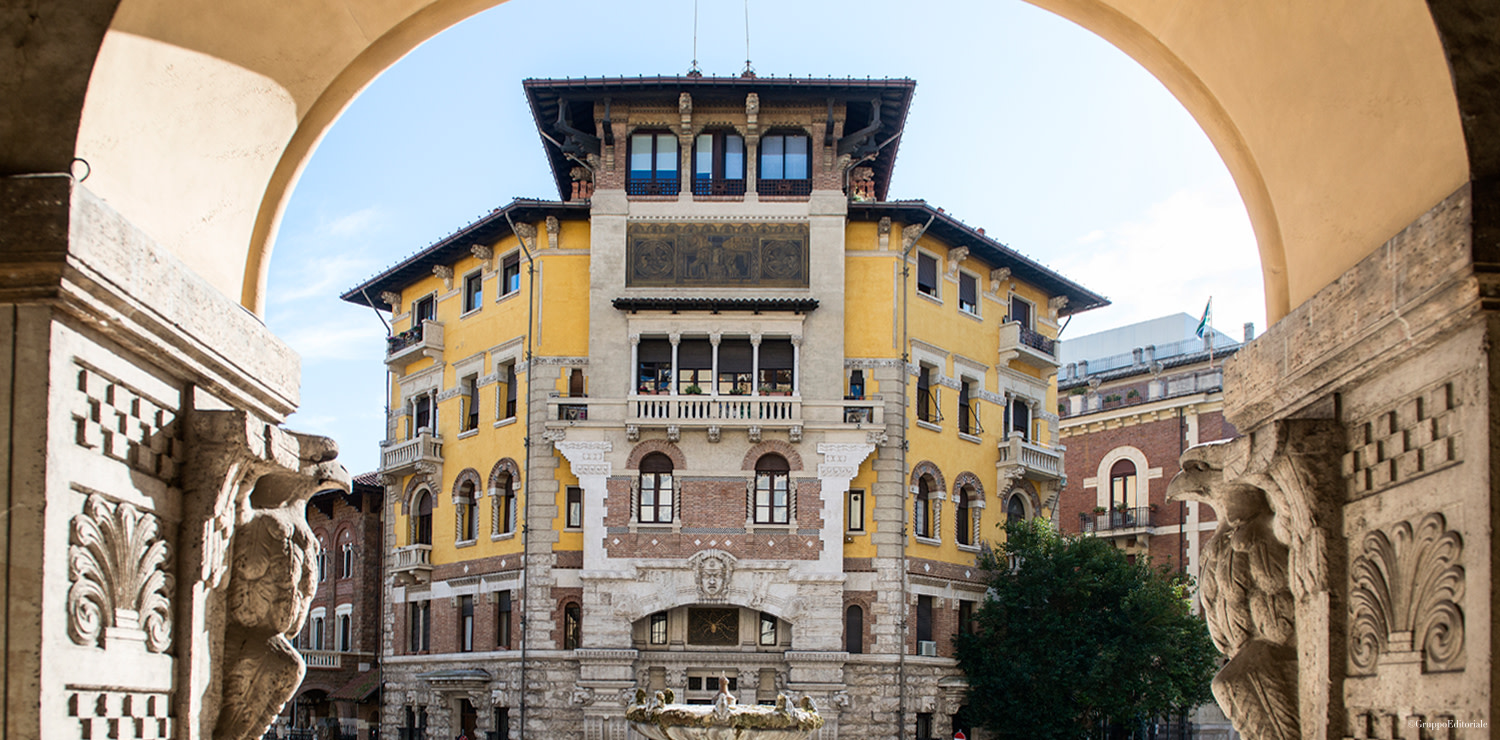Art Nouveau in Rome
An unusual part of Rome, but also in Villa Torlonia with the fascinating Casina delle Civette – House of the Owls
Located in the heart of Rome, just a few kilometers from the historic center, is one of the most characteristic neighborhoods in the city.
Not actually a neighborhood, but a corner of Rome made up of a complex of buildings located in the larger Trieste district, a bizarre mix of Art Nouveau and Art Deco, with infiltrations of Greek, Gothic, Baroque and even medieval art: we are talking about Coppedè.
Pleasant streets for a walk, especially if you have children and want them to discover absolutely different places, a fascinating and surreal route: 26 buildings and 17 villas with Tuscan turrets, Moorish arches, animalesque figures in the frescoed facades and gardens with palm trees, located between the Salaria and Nomentana districts and more precisely, between Piazza Buenos Aires and Via Tagliamento.
The group of buildings, an incredible blend of architectural styles, steep the visitor in the opulent and even slightly fictitious atmosphere of the early 1900s.
The neighborhood was designed and built entirely by the eclectic Florentine architect Gino Coppedè between 1913 and 1926.
The main entrance to the area, from the Via Tagliamento side, is a large lavishly decorated arch, with a grand wrought iron chandelier, and connects the two ambassadors’ palaces.
Before the arch, which leads to Piazza Mincio - the heart of the district - is a niche with a statue of a Madonna and Child.
In the center of the piazza is the Fontana delle Rane, Fountain of the Frogs, built in 1924 and consisting of a central basin, with four pairs of figures, each of which supports a shell on which there is a frog from which water gushes into the pool and, from a second pool, about two meters in height, from another eight frogs.
The fountain, inspired by the turtle fountain in the Jewish ghetto, is also known for the night that the Beatles took a bath in it fully clothed after their concert in the nearby Piper nightclub.
You must bring a camera to capture these strange buildings with the most bizarre shapes if you don’t want to forget all the hidden details.
Piazza Mincio is surrounded by buildings in a variety of shapes and sizes.
The two most important buildings, sumptuously and fantastically decorated, are the Palazzina del Ragno and the Villino delle Fate.
The first, of Assyrian-Babylonian inspiration, is distinguished by a large spider on the facade and a tribute to labor in the form of a decoration depicting a knight with the inscription “labor”.
The Villino delle Fate is characterized by a tribute to Florence with an inscription “Fiorenza bella” and Florentine decorations with Dante and Boccaccio and totally asymmetrical medieval arches and friezes, in a blend of different materials, such as marble, brick, travertine, terracotta and glass.
This evocative place has inspired many directors who have chosen this location to shoot their films: among them Francesco Barilli, Nanni Loy, Carlo Vanzina, and the horror film director Dario Argento, who has done two shoots here.
After the tour through the Coppedè district, it’s time for a sweet stop at the Pasticceria Boni on Via Tagliamento 84 before a walk in Villa Torlonia, the green lung of this area. In the Nomentano district, the Villa is surrounded by 16 hectares of parkland, relaxing nature, tall trees, green meadows, statues, fountains, ponds and many other attractions.
The villa, once owned by the family of prince and banker Giovanni Torlonia, became the Mussolini residence in the 1920s. From 1925 to 1943, he lived there with his wife and children.
After the war it was occupied by the allied troops and abandoned in 1947.
It was then purchased in 1978 by the Municipality of Rome and turned into a public park. Today, the Mussolini bunker can also be seen underneath the Nobile casino, former residence of “Il Duce”.
Within the Parco Verde is the charming Casina delle Civette, the pride of the Park for its distinctive Art Nouveau structure with numerous arcades, turrets, majolica and sculptures, as well as a zoo and phytomorphic theme (animal and plant shapes).
La Casina delle Civette is a mixture of a Swiss hut, a Gothic castle and an Art Nouveau farmhouse and was built as a place to escape to by the Torlonia princes between 1840 and 1930. When construction began, the architects had to follow, to the letter, the strict rules dictated by Alessandro Torlonia, who oversaw every detail of the construction of his dream cottage. He loved solitude, studying and the arts and his dwellings had decorated salons, splendidly colored windows, depicting roses, ivy, swallows, vines and above all owls, displayed everywhere, even on the wallpaper, and in chandeliers and furnishings.
Today this fairy-tale house is home to the Stained Glass Museum. It is definitely one of the more interesting hidden places to explore and children especially love its quirkiness.
They also find the ancient Greek-Roman significance behind the owls to be interesting. In fact, the owl is the animal of Athena, goddess of wisdom, and a symbol for this wisdom. In fact, this nocturnal bird sees in the dark like the wise man who can discern good from evil and is featured throughout the House, hence the name, Casina delle Civette or House of the Owls.
Inside Villa Torlonia, not only are there beautiful princely residences with a wealth of history, but also other attractions for children that make for a wonderful family outing, including the museum of technology: Tecnotown.









